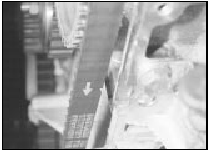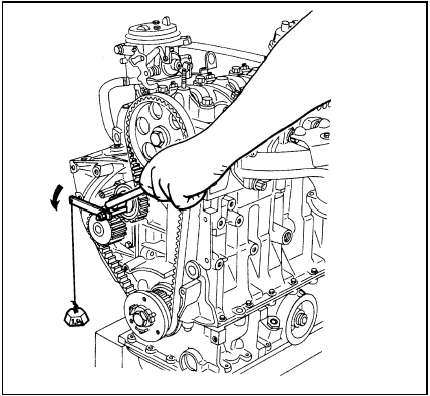
Peugeot 205 Manual
Timing belt - general information, removal and refittingTU series engine in-car repair procedures / Timing belt - general information, removal and refitting
Note: Peugeot specify the use of a special electronic tool (SEEM C.TRONIC type 105 belt tensioning measuring tool) to correctly set the timing belt tension. If access to this equipment cannot be obtained, an approximate setting can be achieved using the method described below. If the method described is used, the tension must be checked using the special electronic tool at the earliest possible opportunity. Do not drive the vehicle over large distances, or use high engine speeds, until the belt tension is known to be correct.
Refer to a Peugeot dealer for advice.
General information
1 The timing belt drives the camshaft and
coolant pump from a toothed sprocket on the
front of the crankshaft. If the belt breaks or
slips in service, the pistons are likely to hit the
valve heads, resulting in extensive (and
expensive) damage.
2 The timing belt should be renewed at the specified intervals (see Chapter 1), or earlier if it is contaminated with oil, or if it is at all noisy in operation (a “scraping” noise due to uneven wear).
3 If the timing belt is being removed, it is a wise precaution to check the condition of the coolant pump at the same time (check for signs of coolant leakage). This may avoid the need to remove the timing belt again at a later stage, should the coolant pump fail.
Removal
4 Disconnect the battery negative lead.
5 Align the engine assembly/valve timing holes as described in Section 3, and lock both the camshaft sprocket and the flywheel in position. Do not attempt to rotate the engine whilst the locking tools are in position.
6 Remove the timing belt centre and lower covers as described in Section 6.
7 Loosen the timing belt tensioner pulley retaining nut. Pivot the pulley in a clockwise direction, using a square-section key fitted to the hole in the pulley hub, then retighten the retaining nut.
8 If the timing belt is to be re-used, use white paint or similar to mark the direction of rotation on the belt (if markings do not already exist) (see illustration). Slip the belt off the sprockets.

7.8 Mark the direction of rotation on the belt if it is to be re-used
9 Check the timing belt carefully for any signs of uneven wear, splitting, or oil contamination.
Pay particular attention to the roots of the teeth. Renew the belt if there is the slightest doubt about its condition. If the engine is undergoing an overhaul, and has covered more than 36 000 miles (60 000 km) with the existing belt fitted, renew the belt as a matter of course, regardless of its apparent condition. The cost of a new belt is nothing when compared to the cost of repairs, should the belt break in service. If signs of oil contamination are found, trace the source of the oil leak, and rectify it. Wash down the engine timing belt area and all related components, to remove all traces of oil.
Refitting
10 Prior to refitting, thoroughly clean the
timing belt sprockets. Check that the tensioner
pulley rotates freely, without any sign of
roughness. If necessary, renew the tensioner
pulley as described in Section 8. Make sure
that the locking tools are still in place, as
described in Section 3.
11 Manoeuvre the timing belt into position, ensuring that the arrows on the belt are pointing in the direction of rotation (clockwise, when viewed from the right-hand end of the engine).
12 Do not twist the timing belt sharply while refitting it. Fit the belt over the crankshaft and camshaft sprockets. Make sure that the “front run” of the belt is taut - ie, ensure that any slack is on the tensioner pulley side of the belt.
Fit the belt over the coolant pump sprocket and tensioner pulley. Ensure that the belt teeth are seated centrally in the sprockets.
13 Loosen the tensioner pulley retaining nut.
Pivot the pulley anti-clockwise to remove all free play from the timing belt, then retighten the nut. Tension the timing belt as described under the relevant sub-heading.
Tensioning without the special electronic measuring tool Note: If this method is used, ensure that the belt tension is checked by a Peugeot dealer at the earliest possible opportunity.
14 Peugeot dealers use a special tool to tension the timing belt. A similar tool may be fabricated using a suitable square-section bar attached to an arm made from a metal strip; a hole should be drilled in the strip at a distance of 80 mm from the centre of the squaresection bar. Fit the tool to the hole in the tensioner pulley, keeping the tool arm as close to the horizontal as possible, and hang a 1.5 kg (3.3 lb) weight from the hole in the tool (see illustration).

7.14 Using the Peugeot special tool to tension the timing belt
In the absence of an object of the specified weight, a spring balance can be used to exert the required force, ensuring that the spring balance is held at 90° to the tool arm. Slacken the pulley retaining nut, allowing the weight or force exerted (as applicable) to push the tensioner pulley against the belt, then retighten the pulley nut.
15 If this special tool is not available, an approximate setting may be achieved by pivoting the tensioner pulley anti-clockwise until it is just possible to twist the timing belt through 90° by finger and thumb, midway between the crankshaft and camshaft sprockets. The deflection of the belt at the mid-point between the sprockets should be approximately 6.0 mm.
16 Remove the locking tools from the camshaft sprocket and flywheel.
17 Using a suitable socket and extension bar on the crankshaft sprocket bolt, rotate the crankshaft through four complete rotations in a clockwise direction (viewed from the righthand end of the engine). Do not at any time rotate the crankshaft anti-clockwise.
18 Slacken the tensioner pulley nut, retension the belt as described in paragraph 14 or 15, then tighten the tensioner pulley nut to the specified torque.
19 Rotate the crankshaft through a further two turns clockwise, and check that both the camshaft sprocket and flywheel timing holes are still correctly aligned.
20 If all is well, refit the timing belt covers as described in Section 6, and reconnect the battery negative lead.
Tensioning using the special electronic measuring tool 21 Fit the special belt tensioning measuring equipment to the “front run” of the timing belt, approximately midway between the camshaft and crankshaft sprockets. Position the tensioner pulley so that the belt is tensioned to a setting of 45 units, then retighten its retaining nut.
22 Remove the locking tools from the camshaft sprocket and flywheel, and remove the measuring tool from the belt.
23 Using a suitable socket and extension bar on the crankshaft sprocket bolt, rotate the crankshaft through four complete rotations in a clockwise direction (viewed from the righthand end of the engine). Do not at any time rotate the crankshaft anti-clockwise.
24 Slacken the tensioner pulley retaining nut, and refit the measuring tool to the belt. If a “new” belt is being fitted, tension it to a setting of 40 units. If an “old” belt is being reused, tighten it to a setting of 36 units. Note: Peugeot state that a belt becomes “old” after 1 hour’s use. With the belt correctly tensioned, tighten the pulley retaining nut to the specified torque.
25 Remove the measuring tool from the belt, then rotate the crankshaft through another two complete rotations in a clockwise direction, so that both the camshaft sprocket and flywheel timing holes are realigned. Do not at any time rotate the crankshaft anticlockwise.
Fit the measuring tool to the belt, and check the belt tension. A “new” belt should give a reading of 51 ± 3 units; an “old” belt should be 45 ± 3 units.
26 If the belt tension is incorrect, repeat the procedures in paragraphs 24 and 25.
27 With the belt tension correctly set, refit the timing belt covers as described in Section 5, and reconnect the battery negative lead.






